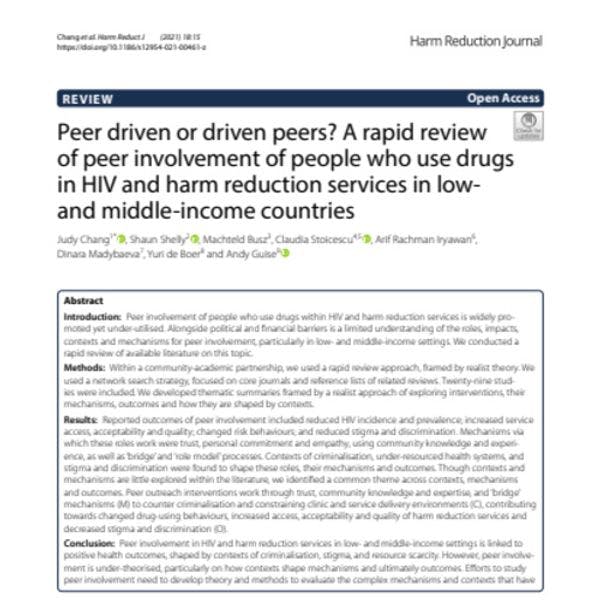Harm Reduction Journal
Peer driven or driven peers? A rapid review of peer involvement of people who use drugs in HIV and harm reduction services in low- and middle-income countries
By Judy Chang et al. / Harm Reduction Journal
Peer involvement in HIV and harm reduction programmes is widely promoted as essential to efective responses to the health, social, and political challenges faced by people who use drugs. Despite the recognition of meaningful community involvement as a principle, in practice there is a consistent lack of funding and political support. Alongside ideological and fnancial barriers, peer involvement within harm reduction services has received less research attention, especially in the Global South. Tere is, therefore, a need to review and critically assess the evidence-base for peer involvement in order to better support ongoing research, policy and advocacy debates.
From the very beginnings of harm reduction, people who use drugs have been central to its development and delivery. Studies, mainly focused on high-income settings, support the positive impact of diferent forms of peer involvement on service reach, accessibility and quality, as well as on the lives of peers themselves. Te varied engagement of peers follows a long history of peer-organising in regions including North America, Western Europe, Oceania and East and South-East Asia, either working behind the scenes or at the forefront of needle distribution services, harm reduction education, peer support and community-based research initiatives. However, the available evidence centers on justifying the broader approach or outcomes, rather than on the specifc operations and contexts for peer-involved programming. Past reviews note the limited understanding of the processes and mechanisms for this work, particularly in low- and middle-income countries (LMICs). Addressing this gap, particularly within low and middle-income settings, could enhance contemporary debates on peer involvement within global health and development.
Currently, there is a disjuncture between high-level support for peer involvement and the limited role of peers in practice. Trough their endorsement of the 2016 Political Declaration on HIV/AIDS, UN member states committed to allocating 30% of funding for HIV programmes towards community-led responses by 2030. Aligned with this goal, communities of key populations, that is gay and bisexual men, people who inject drugs, sex workers and transgender people published Implementation Tools promoted community-led initiatives in collaboration with UN agencies, which have been recognised as global normative guidance by multi-lateral funding agencies. Nonetheless, progress by policymakers and programme managers toward meaningfully involving people who use drugs in HIV and harm reduction programming remains limited, as evidenced by ongoing debates within the UNAIDS Programme Coordinating Board on how to operationalise the 30% target on funding community-led responses in the 2016 Political Declaration on HIV/AIDS. Based on our personal participation in these policy debates, we consider that an enhanced understanding of the evidence for operations and impacts of peer involvement could be a core step in the successful operationalisation of the principle of peer involvement.
